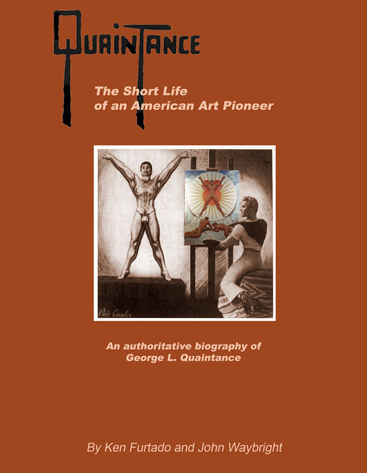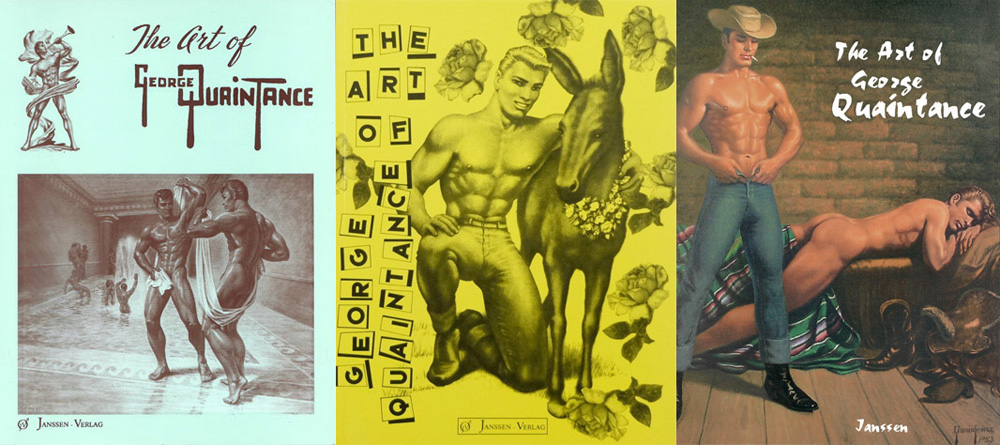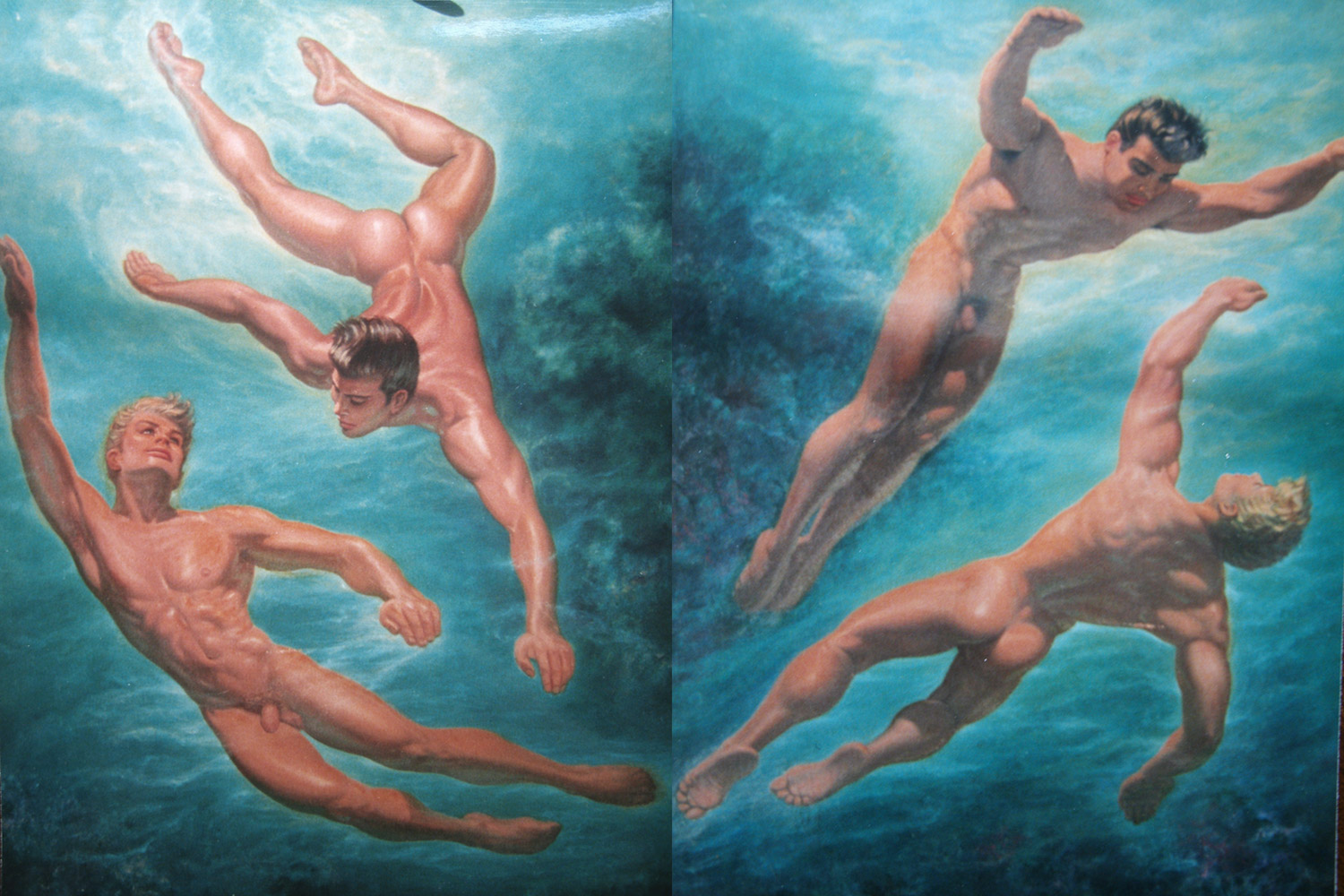- Details
- Written by: Ken Furtado
Three books have been published about George Quaintance, not counting the 2014 ebook.
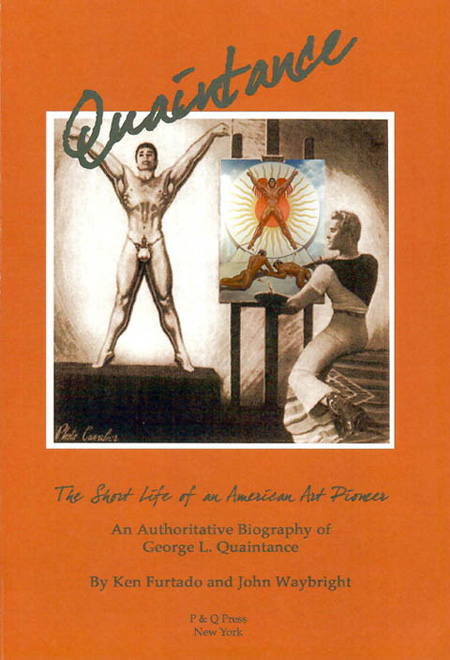 The first — although not chronologically — is a version of the biography I co-authored with John Waybright. In the end stages of John's life, in 2013, a friend of his paid to have about 20 paperback copies of our book privately printed. It was to be a birthday surprise for John. The finished book was about 6x9 inches, 142 pages, and had several glossy plates, some of which were in full color.
The first — although not chronologically — is a version of the biography I co-authored with John Waybright. In the end stages of John's life, in 2013, a friend of his paid to have about 20 paperback copies of our book privately printed. It was to be a birthday surprise for John. The finished book was about 6x9 inches, 142 pages, and had several glossy plates, some of which were in full color.
That friend's accomplice, however, acquired an early, uncorrected and incomplete version of the manuscript. John passed away before he saw it, or knew about it. (Thank goodness!) I have a copy and I hope that no one else does.
The second book, The Art of George Quaintance, appeared in three editions, all with different covers and slightly different contents.
In 1989, Volker Janssen of Janssen Verlag (Publishers) published The Art of George Quaintance in an edition of 1000 copies. It has a pale blue cover featuring Spartan Soldiers Bathing. The text is in German. At that time, Janssen owned several works by Quaintance, so he exhibited them at his gallery in Berlin. Hoping to sidestep any possible copyright issues with the Quaintance estate, he used that exhibition as a pretext for including photos in the book of every one of Quaintance's known paintings of the male physique era.
As Janssen explained in an email to me, "I had the opportunity to purchase some rare original Quaintance paintings and photographs, and as a result the first Quaintance exhibition finally took place in Berlin, in 1989. The first book of his work, The Art of George Quaintance, was published, and it became the catalogue for the show."
- Details
- Written by: Ken Furtado
An unusual photograph from Quaintance's male physique period sold on eBay, April 18, 2024. The title was "Trail (sic) by Combat Men Knife Fighting Art Picture Quaintance."
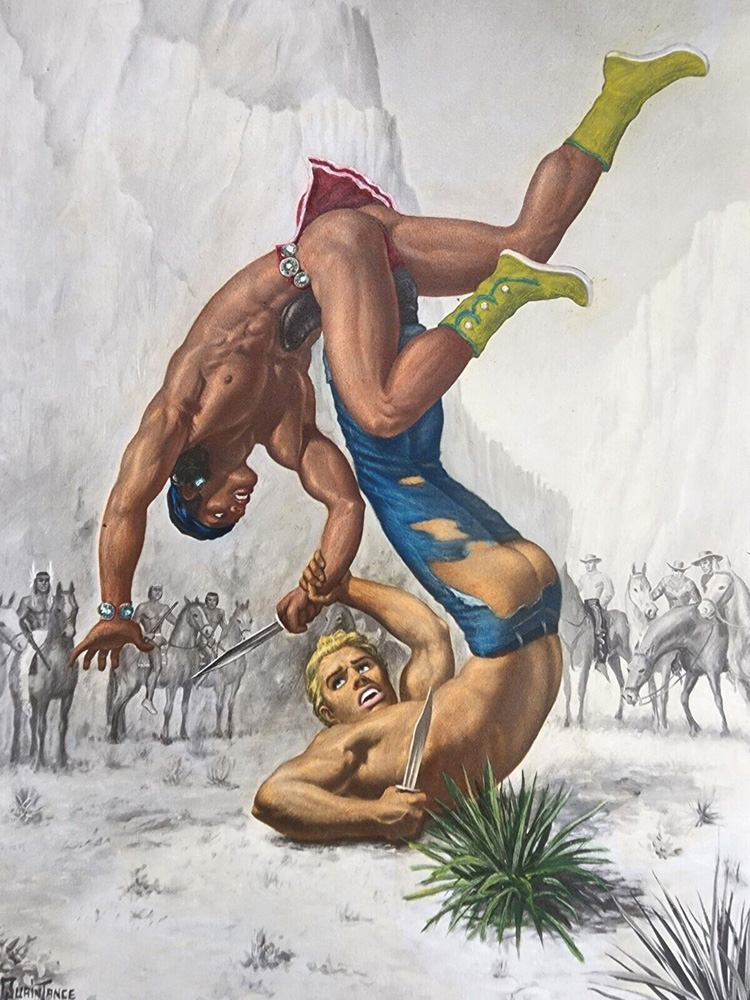 The photograph was an original black and white photo of the canvas Trial by Combat. Online images showed the correct studio imprint and other information. It was typical of the thousands of black and white photographs produced by the Quaintance Studio in its heyday, measuring about 8x10 inches and printed on heavy stock. Slight age discoloration and some rippled edges added bona fides.
The photograph was an original black and white photo of the canvas Trial by Combat. Online images showed the correct studio imprint and other information. It was typical of the thousands of black and white photographs produced by the Quaintance Studio in its heyday, measuring about 8x10 inches and printed on heavy stock. Slight age discoloration and some rippled edges added bona fides.
But lo, the two central figures — and a murderous looking yucca — are in vivid color. The listing gives no explanation for this, nor does it indicate whether the seller knew this was an oddball item.
The photo sold for $50.
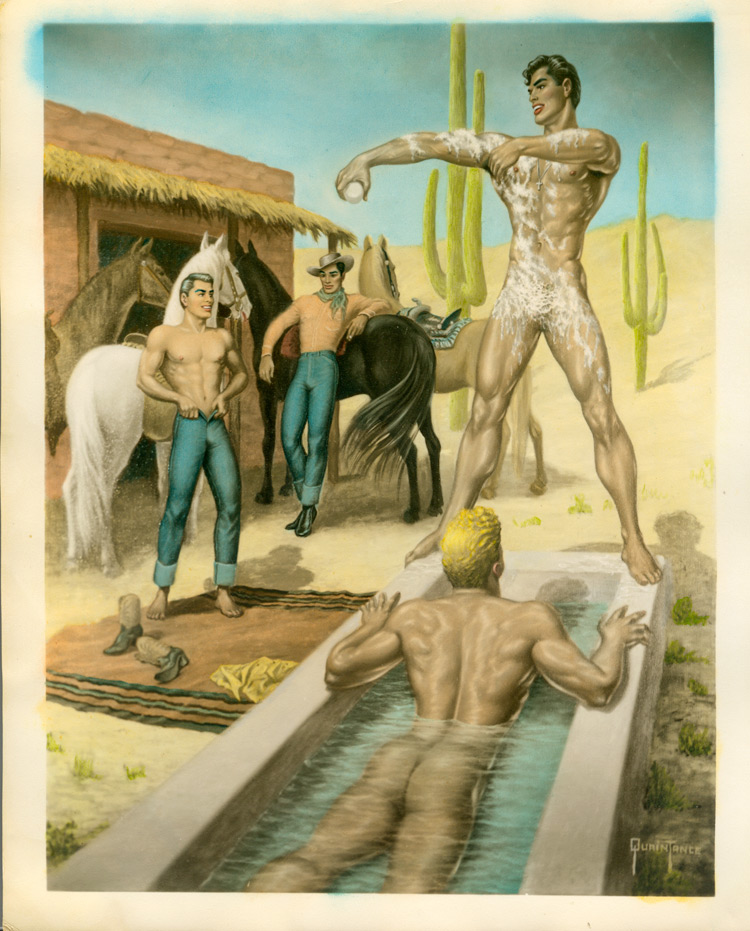 This is not the first instance I've seen of the Studio's b&w photos with color added, but this is the first that added color selectively, rather than to the entire image, and the first to use vivid non-watercolor ink or paint. Other colorized images used watercolors in pastel washes that sometimes bled into the margins, such as this example of Morning.
This is not the first instance I've seen of the Studio's b&w photos with color added, but this is the first that added color selectively, rather than to the entire image, and the first to use vivid non-watercolor ink or paint. Other colorized images used watercolors in pastel washes that sometimes bled into the margins, such as this example of Morning.
The burning question is: who added the color? It seems that new ways of misusing and abusing the Quaintance estate continue to emerge. According to US copyright law, works created after 1923, but before 1978, are protected for 95 years from the date of publication. Enforcement, however, requires that someone is minding the store.
Everything on this website is free. If you enjoy reading these articles, please consider making a donation to help defray the costs of hosting and domain registration. The "Donate" button will get you started. Thank you.
- Details
- Written by: Ken Furtado
I have William Butler Yeats to thank for the title of this article, which has nothing to do with George Quaintance.
If you visit here often, you have noticed that the site has been inactive for about a year. Blame technology.
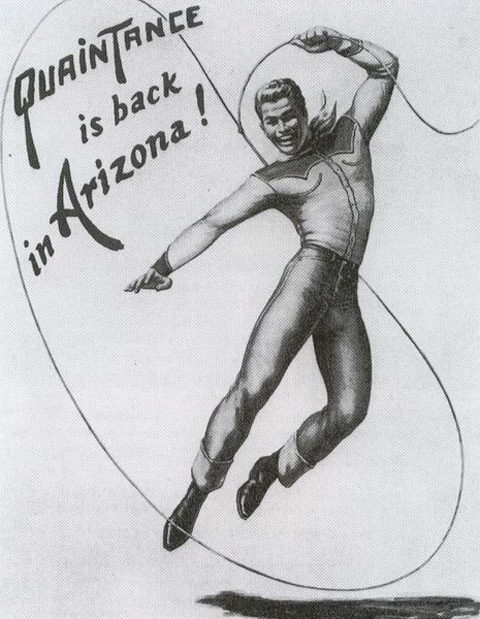 At the end of 2022, I was notified that my content management system (CMS) — the backbone on which the site is built — was outdated. In addition to requiring an update, the entire site needed to be moved to a new server, capable of handling the new CMS. I hired a person to do that who, working with my web host, moved and updated the site. Somehow, they wrecked it.
At the end of 2022, I was notified that my content management system (CMS) — the backbone on which the site is built — was outdated. In addition to requiring an update, the entire site needed to be moved to a new server, capable of handling the new CMS. I hired a person to do that who, working with my web host, moved and updated the site. Somehow, they wrecked it.
The web host was useless and helpless. One by one, I engaged different people to fix the problem, but $2000 and several "fixes" later, it became apparent that it was easier to make promises than to deliver on them.
So, I sent a cry for help to the universe using Craigslist. It drew nearly 100 replies. Having no basis for knowing who truly knew whereof they spoke, I retained the first person who replied. More wasted time, money and energy. Screening the other replies, I emailed or texted a few who seemed more promising. Got the brass ring with John!
Now I have an updated CMS, a bug-free site (fingers crossed), and a new web host. I can finally resume posting articles about the guy you came to hear about, George Quaintance. This image of him from a 1953 magazine ad seemed appropriate to illustrate this article.
In the meantime, there has been a dearth of new information about Quaintance since Covid hit, so if you have stories to tell or images to share, please direct them my way.
BTW, making a donation is a great opportunity to help defray the costs I've incurred in keeping this blog alive. As it says elsewhere, all parts of this site are free and I derive no income from it. There's a "Donate" button at the right and you can use Zelle, Venmo, or Paypal. Thank you.
- Details
- Written by: Ken Furtado
Admirers and scholars of George Quaintance should also direct their attention to one of his contemporaries: artist Christopher Clark. I have written about Clark before (link). His male physique work is notoriously scarce and all-but-unknown (but it is gorgeous)!
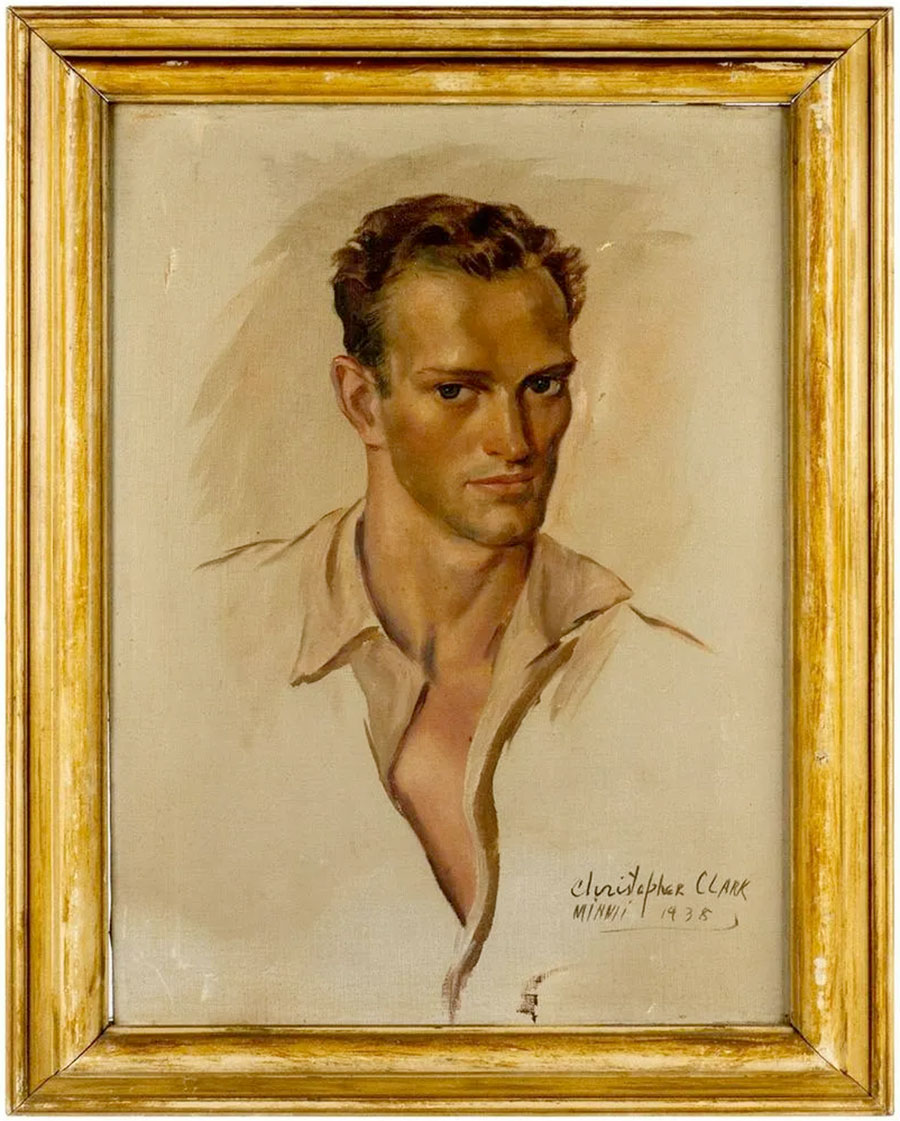 In January, an original Clark oil painting was offered at auction: a bust of a young man with the top of his shirt unbuttoned. The painting is signed and dated, "Christopher Clark Miami 1938." The canvas measures 18 by 26 inches and the frame 24 by 31.5. It is shown here with the permission of the auction house, Lion and Unicorn. The winning bid was $2400.
In January, an original Clark oil painting was offered at auction: a bust of a young man with the top of his shirt unbuttoned. The painting is signed and dated, "Christopher Clark Miami 1938." The canvas measures 18 by 26 inches and the frame 24 by 31.5. It is shown here with the permission of the auction house, Lion and Unicorn. The winning bid was $2400.
The auction listing provided more information about Clark. After leaving his native Florida, he studied art and theater in New York, then returned to Florida. Details of his work there, including exhibitions and prizes won, can be found in Alfred R. Frankel's, Artists of Old Florida 1840-1950, which compares his work to that of Thomas Hart Benton. The entire book can currently be downloaded free at https://artistsofoldflorida.com.
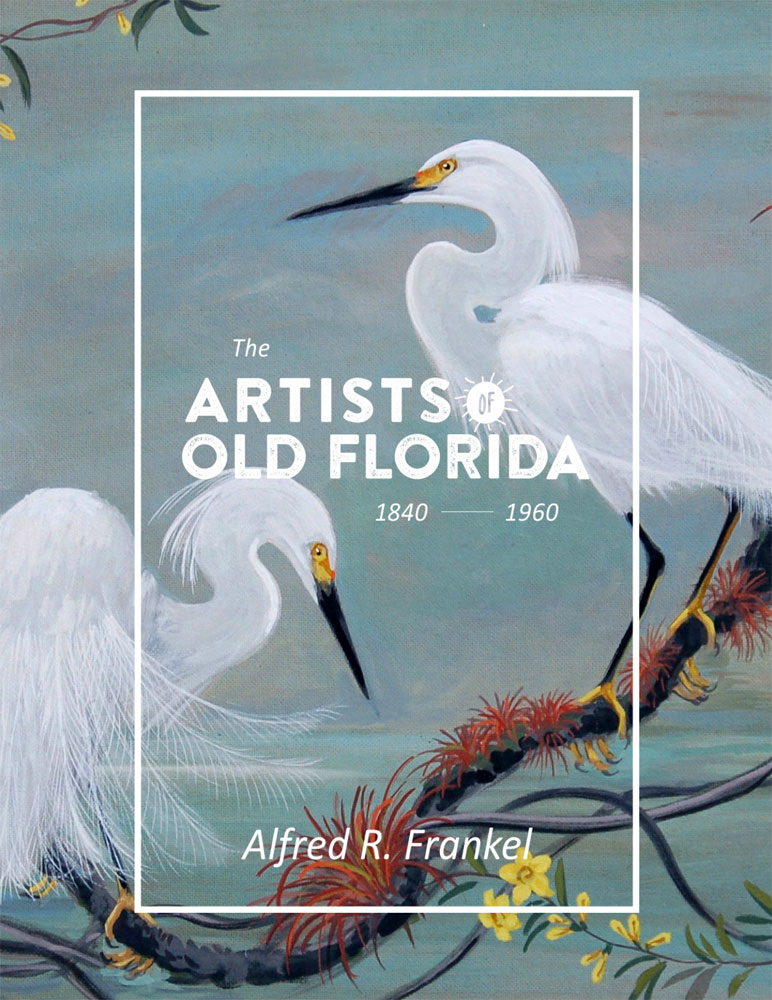 The listing goes on to say that Clark was close with automobile magnate Walter Chrysler Jr., and that he curated Chrysler's collection of old Dutch masters.
The listing goes on to say that Clark was close with automobile magnate Walter Chrysler Jr., and that he curated Chrysler's collection of old Dutch masters.
Chrysler provides a direct link to George Quaintance. Walter P. “Freddie” Chrysler Jr., was the scion of the founder of the great American automobile manufacturing company, Chrysler. Though twice married, Freddie’s homosexuality was an open secret. He and George reputedly had an intense affair. Freddie was famous for giving his boyfriends lavish gifts, and George got a 20-foot convertible — a testament to how allegedly hot he was as a lover and boon companion.
About that gift, Rev. Robert W. Wood (another of George's lovers) wrote, in a letter to Durk Dehner of the Tom of Finland Foundation, "George told me that Walter P. Chrysler Jr. had given a white 4-door Chrysler convertible to him. As you may know, at one time Chrysler Jr. was the 'belle' of Provincetown, and was known for his generosity to his boyfriends." George exulted in driving around his hometown in this convertible with his boyfriends, which proved somewhat disconcerting to the neighbors.
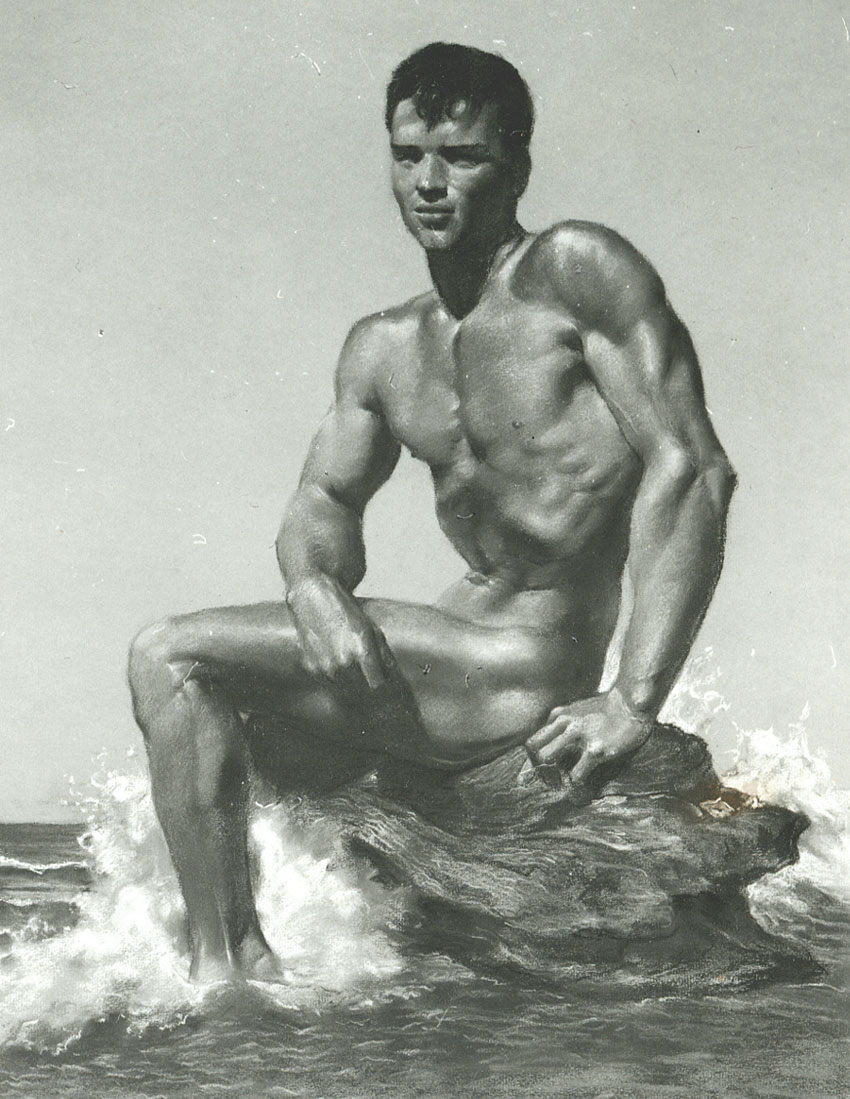 Glenn Bishop, a hugely popular physique model of the 1950s, provides another link between Clark and Quaintance, as they both painted him. Clark's portrait of Bishop is shown here. Quaintance's painting of Glenn Bishop is based on a photo taken by Bob Delmonteque, both model and mentor to Clark!
Glenn Bishop, a hugely popular physique model of the 1950s, provides another link between Clark and Quaintance, as they both painted him. Clark's portrait of Bishop is shown here. Quaintance's painting of Glenn Bishop is based on a photo taken by Bob Delmonteque, both model and mentor to Clark!
Clark passed away suddenly at his home in Tampa, on July 2, 1973 at the age of 70. If you know more about Clark, please write to me.
Thank you to Steven Kozlowski for providing information for this blog entry.
Everything on this website is free. If you enjoy reading these articles, please consider making a donation to help defray the costs of hosting and domain registration. The "Donate" button will get you started. Thank you.
- Details
- Written by: Ken Furtado
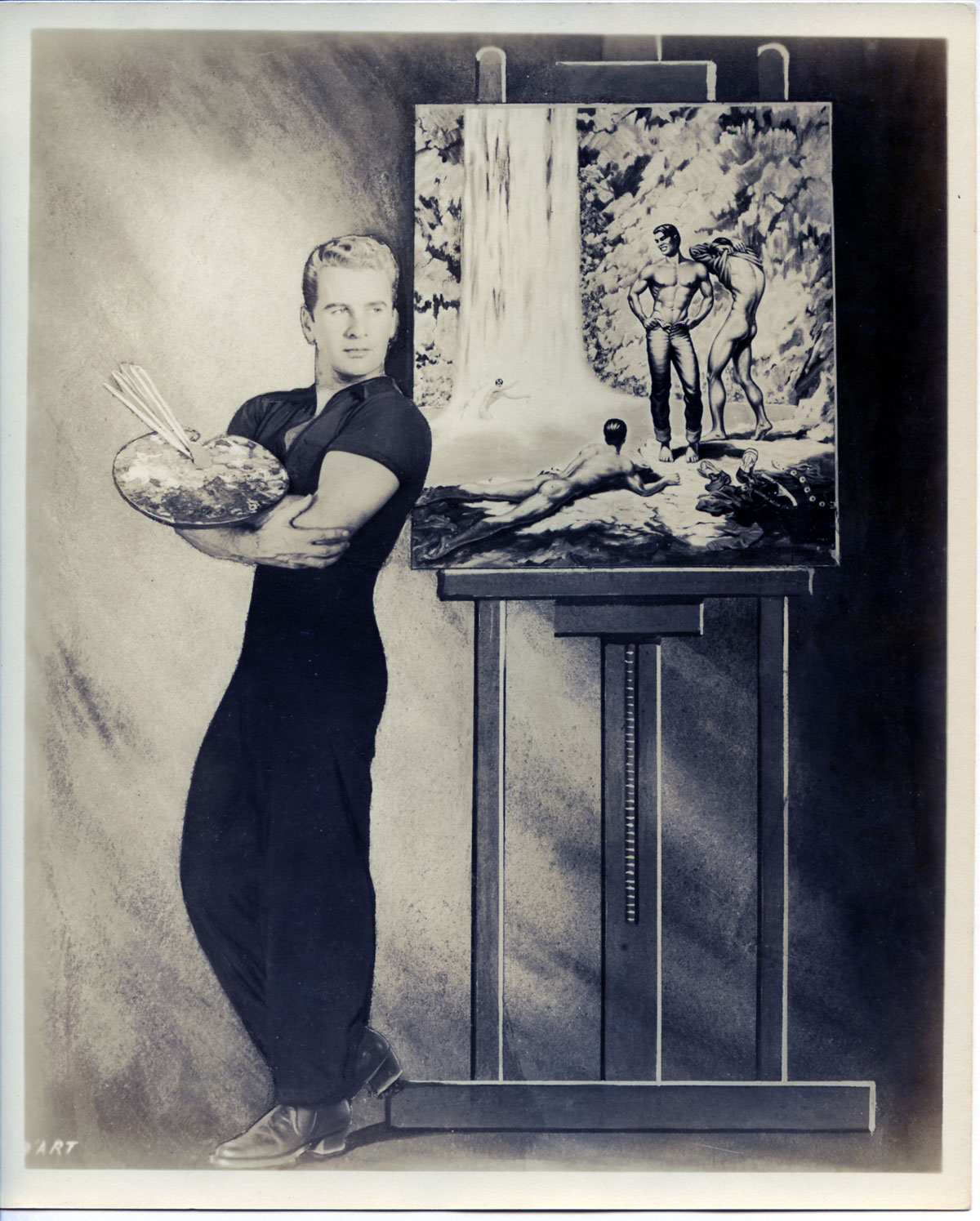 On Aug. 18, the Swann Auction Gallery of NYC held its annual auction of LGBTQ+ art, material culture and history. Of the 443 lots offered, four were Quaintance material.
On Aug. 18, the Swann Auction Gallery of NYC held its annual auction of LGBTQ+ art, material culture and history. Of the 443 lots offered, four were Quaintance material.
Anyone who thinks the USA is on the cusp of a recession should be encouraged by the robust bidding, which exceeded five-figure bids for about 18 of the items offered. If you add the 30% buyers fee for each lot, state sales tax based on the domicile of the high bidder, plus packing and shipping, successful bidders forked over a boatload of dollars that day.
 The first Quaintance item was an 8x10 duotone photograph of the artist, sporting a blond wig, standing beside his easel, on which rests the painting Havasu Creek. The photo is signed and inscribed. Quaintance was fond of this photo and he kept copies on hand to give to friends and buyers. I owned two such photos myself, both of which I sold on eBay in 2013. One, similarly signed and inscribed, sold for $131.50. The other, which was not, sold for $10. The latter photo is shown here. Hammer price of the photo at the Swann auction was $700.
The first Quaintance item was an 8x10 duotone photograph of the artist, sporting a blond wig, standing beside his easel, on which rests the painting Havasu Creek. The photo is signed and inscribed. Quaintance was fond of this photo and he kept copies on hand to give to friends and buyers. I owned two such photos myself, both of which I sold on eBay in 2013. One, similarly signed and inscribed, sold for $131.50. The other, which was not, sold for $10. The latter photo is shown here. Hammer price of the photo at the Swann auction was $700.
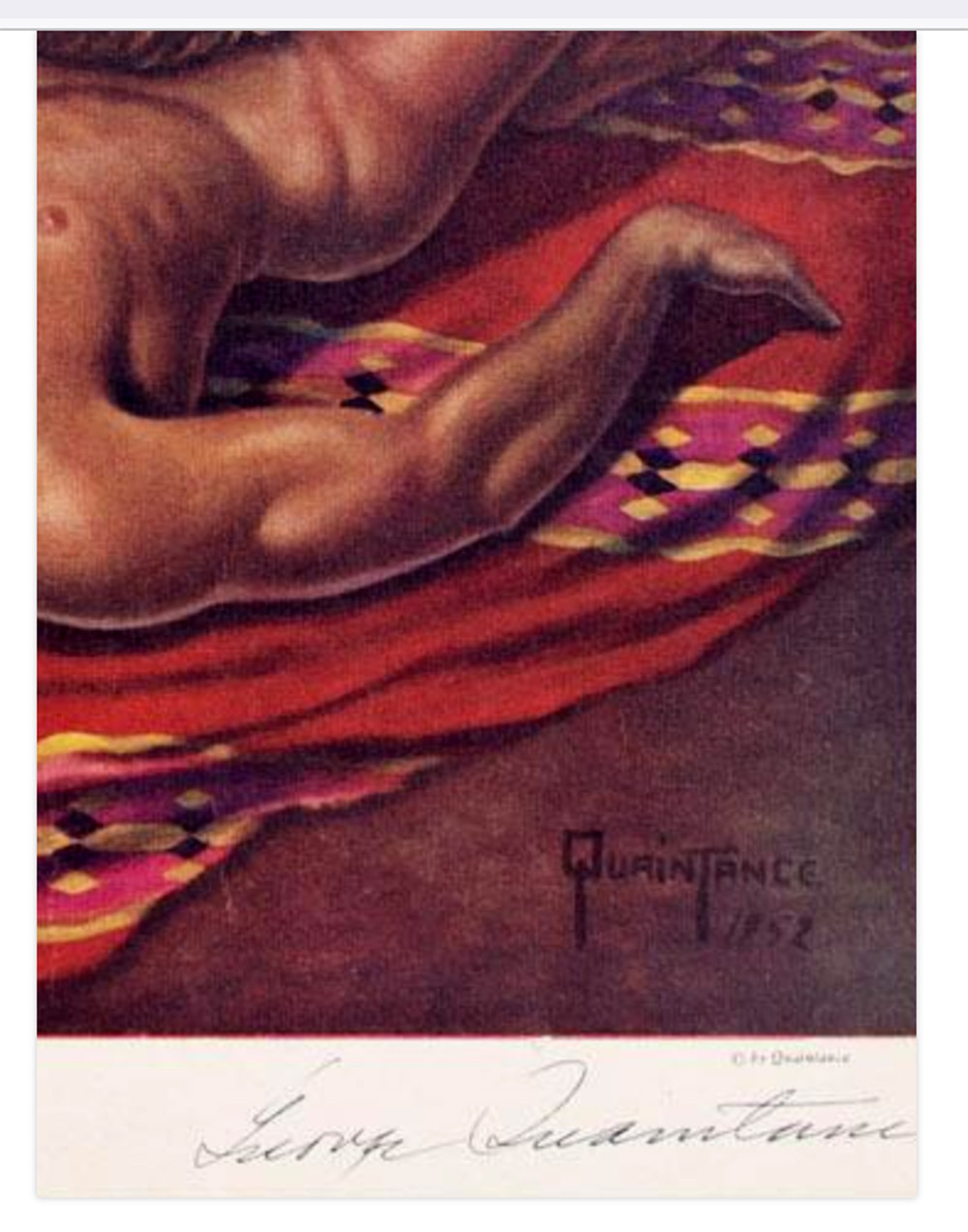 The next Quaintance lot featured the all-blue Moonflower canvas that was the subject of my July 28 blog entry. The auction house called this painting Moonglow, and it failed to attract the minimum opening bid of $4400. The gallery subsequently notified me that the painting sold the following day for $4500.
The next Quaintance lot featured the all-blue Moonflower canvas that was the subject of my July 28 blog entry. The auction house called this painting Moonglow, and it failed to attract the minimum opening bid of $4400. The gallery subsequently notified me that the painting sold the following day for $4500.
 A signed copy of the Siesta lithograph was the next GQ item. Although the opening bid was set at $1100, the auctioneer opened the bidding in the $400 range and the winning bid was $900.
A signed copy of the Siesta lithograph was the next GQ item. Although the opening bid was set at $1100, the auctioneer opened the bidding in the $400 range and the winning bid was $900.
The final Quaintance lot was the Narcissus sculpture. Although these sculptures were produced and sold in simple terra cotta, a previous owner of this particular one coated it in white lacquer. The hideous result did not prevent a buyer from spending $2000 to acquire it.
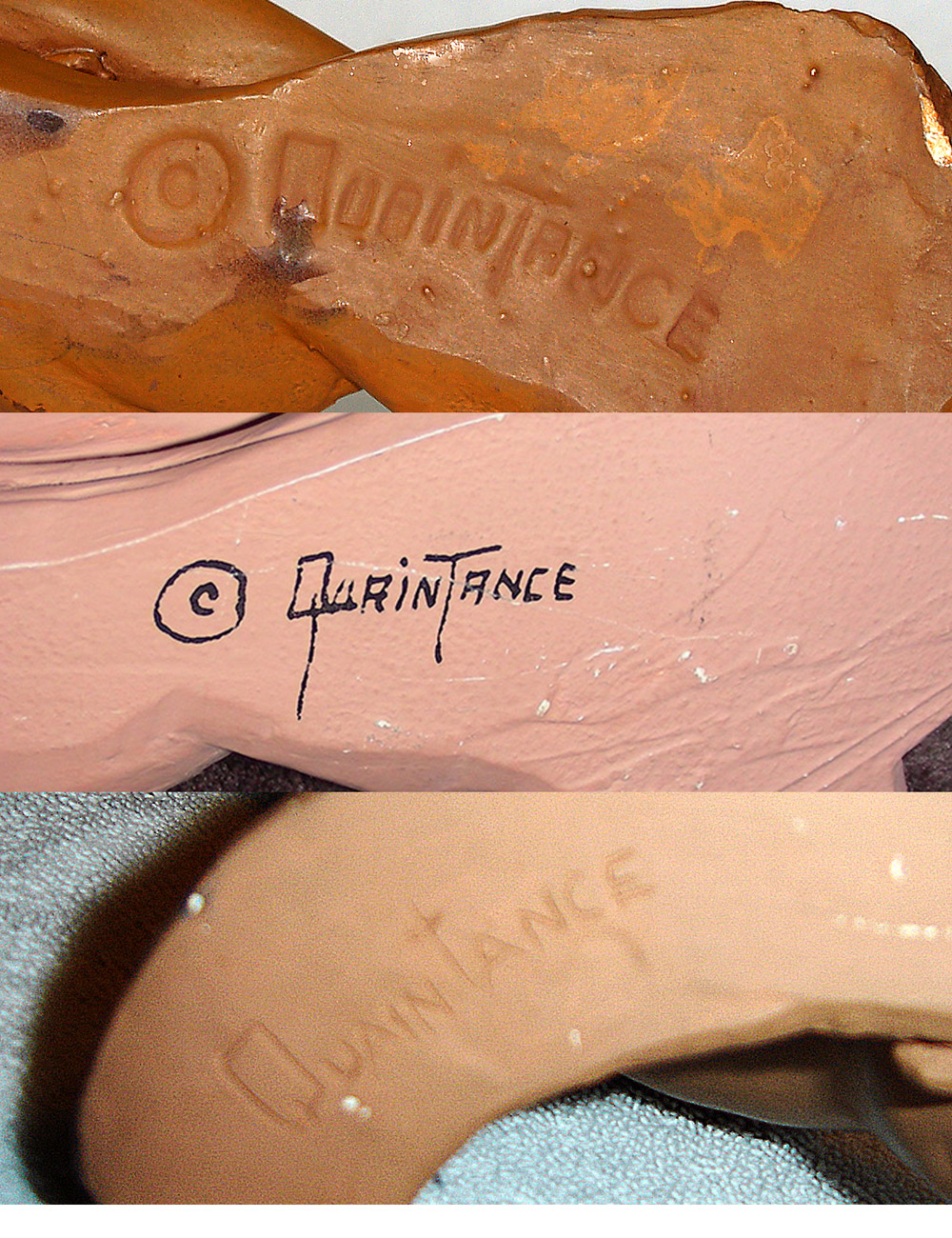 Quaintance employed three ways to sign his sculptures: his name scratched into the wet hydrostone (clay) with a stylus; a stamped imprint; or an actual signature in ink. This Narcissus is signed in ink. The Quaintance Studio continued to do business after George's death, and it's plausible that the imprinted signature and the stylus-inscribed signature were made by one of George's business partners when he was no longer there to add his actual signature.
Quaintance employed three ways to sign his sculptures: his name scratched into the wet hydrostone (clay) with a stylus; a stamped imprint; or an actual signature in ink. This Narcissus is signed in ink. The Quaintance Studio continued to do business after George's death, and it's plausible that the imprinted signature and the stylus-inscribed signature were made by one of George's business partners when he was no longer there to add his actual signature.
Everything on this website is free. If you enjoy reading these articles, please consider making a donation to help defray the costs of hosting and domain registration. The "Donate" button will get you started. Thank you.
- Details
- Written by: Ken Furtado
Upon beginning research for the Quaintance bio, I created a database to record the date, dimensions, models and current location/ownership of every painting of the male physique period that I could document.
Fast-forward 19 years and many remain unaccounted for. I expected that a letter discovered in 2003, in a scrapbook at the Tom of Finland Foundation, would lead me to two canvases. The writer spoke of finding "a pair in their original frames" at an antique store. He thought they had "a wonderful fifties naïve quality to them," although he did not know when he bought them who George Quaintance was. The letter was written in 1995. It gave no clue as to which paintings he found.
Despite eight years having passed, I wrote to the fellow — snail mail — and never got a reply. Until 14 years later. Snail mail, indeed! He wrote:
I didn't actually know who George was when I bought the paintings and research had to be done the old-fashioned way. Two sources that helped was the Society of Illustrators and Roger Reed at the Illustration Gallery as far as having a minimal amount of biographical information. Though I didn't know George, I did recognize his style from something in the past, I think it was from the fitness magazines. The shop owner was an older gay gentleman and he had them in a closet. He pulled them out. The shop owner had a huge crush on me and so he was kind enough to allow me to pay for the paintings over time.
The paintings turned out to be Coral Reef and Sunlit Depths.
He went on to say, "The paintings are big. These are approximately 3x4, still in their original frames. I've owned them now for over twenty years (ed. note: this was in 2017). I should make some digital photos, as I'm sure I mentioned in the actual paintings there are no accidental waves covering their anatomy, as pictured frequently in books. The men are full nudes sans water foam. One swimmer is cut, the other not."
The frontal nudity is remarkable. Due to obscenity laws at the time, Quaintance took great care to conceal the genitals of every male he painted. Only in his sculptures — Ocean Wave, Narcissus, and two of Neptune's Children — did he ever show a penis.
Earlier this year, I persuaded the owner to send me photos of the pair. The image quality is mediocre, one hand is cut off and there's no visible signature on either canvas. Yet there they are. Mirabile visu! According to the Quaintance Studio, the models were Jim Glasper (buns), Edwardo and Bill Bredlau.
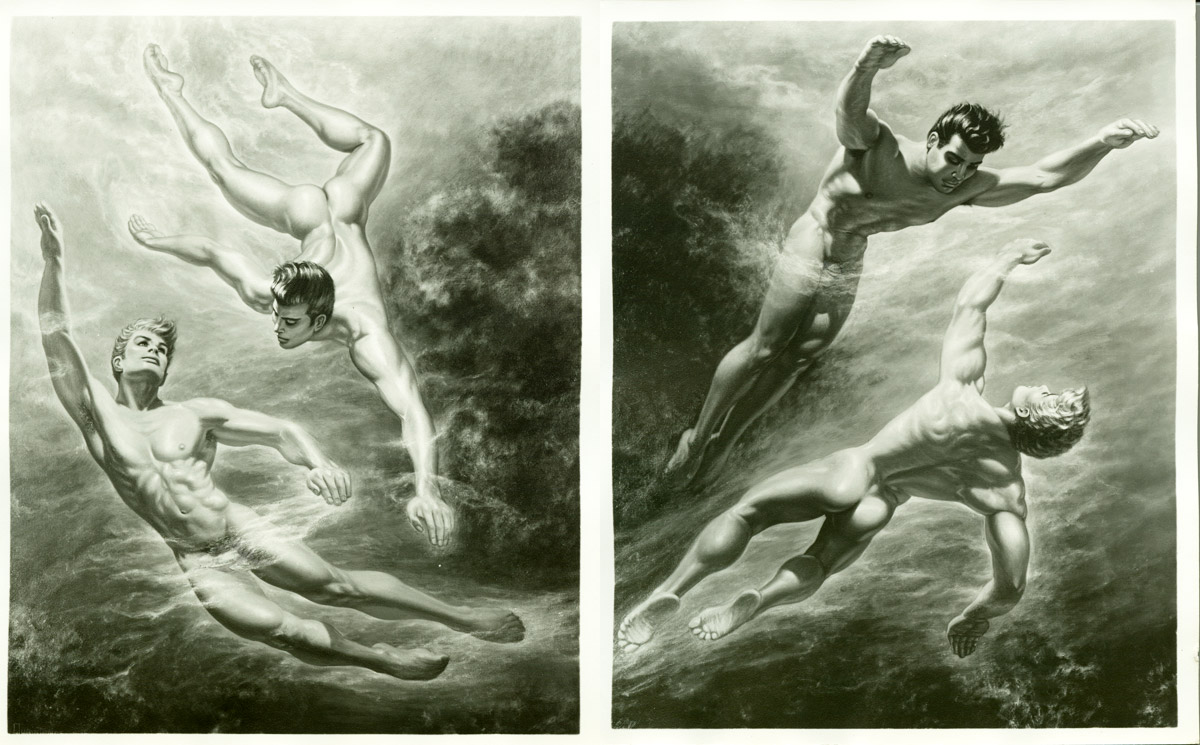 It appears that the canvases are not dated. Their present owner concurs, "The sig is on the front. No date as I recall. They are actually crated."
It appears that the canvases are not dated. Their present owner concurs, "The sig is on the front. No date as I recall. They are actually crated."
The Rev. Bob Wood, a former lover and long-time correspondent of Quaintance (and about whom I have written elsewhere), dated them at 1956. Wood also said the duo was a private commission that later disappeared. Perhaps the fact that the canvases were destined to go directly from easel to buyer allowed George to make an exception about showing the genitals.
One hopes that time will reveal more of this story; the owner is incommunicado once more. A copy of the black-and-white photo versions of the paintings that were sold by the Quaintance Studio is included for comparison. Coral Reef is the photo on the right.
Everything on this website is free. If you enjoy reading these articles, please consider making a donation to help defray the costs of hosting and domain registration. The "Donate" button will get you started. Thank you.

